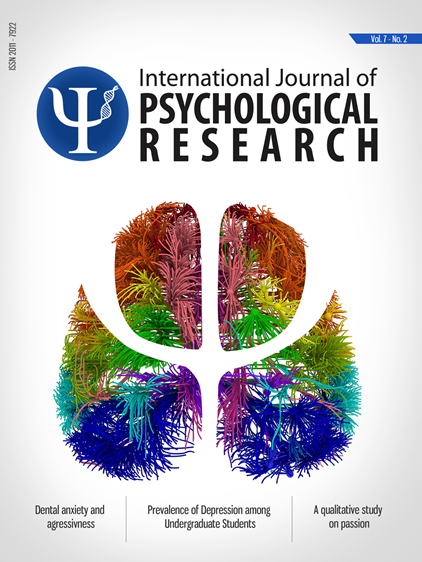To give up copyright, the authors allow that, International Journal of Psychological Research, distribute the work more broadly, check for the reuse by others and take care of the necessary procedures for the registration and administration of copyright; at the same time, our editorial board represents the interests of the author and allows authors to re-use his work in various forms. In response to the above, authors transfer copyright to the journal, International Journal of Psychological Research. This transfer does not imply other rights which are not those of authorship (for example those that concern about patents). Likewise, preserves the authors rights to use the work integral or partially in lectures, books and courses, as well as make copies for educational purposes. Finally, the authors may use freely the tables and figures in its future work, wherever make explicit reference to the previous publication in International Journal of Psychological Research. The assignment of copyright includes both virtual rights and forms of the article to allow the editorial to disseminate the work in the manner which it deems appropriate.
The editorial board reserves the right of amendments deemed necessary in the application of the rules of publication.
Resumen
La ansiedad dental es definida como la respuesta a un estímulo estresante que puede pertenecer a un contexto dental. El tratamiento dental puede provocar excitación y respuestas agresivas relacionadas a múltiples fuentes de motivación que han sido examinadas por la literatura.
La hipótesis a evaluar en el presente texto consiste en hasta que alcance la ansiedad dental puede ser explicada al observar solamente características del paciente o al considerar agresividad latente que podría ser manifestada antes y durante el tratamiento dental.
Los resultados de este estudio deberían dar algunas indicaciones a los dentistas para entender mejor la presencia de una mayor o menor ansiedad asociada a tratamientos ortodónticos para generar una asistencia apropiada y, eventualmente, para ayudar a los pacientes a desarrollar estrategias para superar tales dificultades.Como consecuencia, debería estar claro como intervenir en cada componente de la ansiedad dental y/o agresividad podría tener un impacto positivo en el resultado de un tratamiento dental.
Palabras clave:
Referencias
American Psychiatric Association (1994). Diagnostic and Statistical Manual of Mental Disorders (4th ed). Washington, DC: American Psychiatric Association.
Anttila, S., Knuuttila, M., Ylöstalo, P. & Joukamaa, M. (2006). Symptoms of depression and anxiety in relation to dental health behavior and self-perceived dental treatment need. European Journal of Oral Sciences, 114, 109-114.
Becker, S., Al Zaid, K. & Al Faris, E. (2002). Screening for somatization and depression in Saudi Arabia: A validation study of the PHQ in primary care. International Journal of Psychiatry in Medicine, 32, 271-283.
Buss, A. H. & Perry, M. P. (1992). The aggression questionnaire. Journal of Personality and Social Psychology, 63, 452-459.
Corah, N.L. (1969). Development of a dental anxiety scale. Journal of Dental Research, 48, 596.
Corah, N.L., Gale, E.N. & Illig, S.J. (1978). Assessment of a dental anxiety scale. The Journal of the American Dental Association, 87, 816-819.
Doebling, S. & Rowe, M.M. (2000). Negative perceptions of dental stimuli and their effects on dental fear. Journal of Dental Hygiene, 74 (2), 110-116.
Economou, G.C. & Honours, B. (2003). Dental anxiety and personality: Investigating the relationship between dental anxiety and self-consciousness. Journal of Dental Education, 267, 970-980.
Jören, P., Jackowski, J., Gängler, P., Sartory, G. & Thom, A. (2000). Fear reduction in patients with dental treatment phobia. British Journal of Oral and Maxillofacial Surgery, 38, 612-616.
Kaspers, S. (2001). Depression and anxiety-separate or continuum? World Journal Biological Psychiatry, 162, 162-163.
Locker, D. (2003). Psychological consequences of dental fear and anxiety. Community Dentistry and Oral Epidemiology, 31, 144-151.
Locker, D., Thomson, W.M. & Poulton, R. (2001a). Psychological disorder, conditioning experiences, and the onset of dental anxiety in early adulthood. Journal Dental Research, 80, 1588-1592.
Locker, D., Thomson, W.M. & Poulton, R. (2001b). Onset and patterns of change in dental anxiety in adolescence and early adulthood: a birth cohort study. Comm Denth Health 18 (2), 99-104.
Maggirias, J. & Locker, D. (2002). Five-year incidence of dental anxiety in an adult population. Community Dental Health, 19, 173-179.
Quteish Taani, D.S. (2002). Dental anxiety and regularity of dental attendance in younger adults. Journal Oral Rehabilitation, 29(6), 604-608.
Settineri, S., Mallamace, D., Muscatello, M.R., Zoccali, R. & Mento, C. (2013). Dental anxiety, psychiatry and dental treatment: How are they linked? Open Journal of Psychiatry, 3, 168-172.
Settineri, S., Mucciardi, M., Leonardi, V., Mallamace, D. & Mento, C. (2010). The emotion of disgust in Italian students: A measure of the Synthetic Disgust Index. International Journal of Psychological Research. 6, 1, 21-29.
Van Toller, S. (1988). Odours, emotion and psychophysiology. International Journal of Cosmetic Sciences, 10, 171– 197.

































